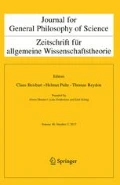Abstract
I defend a realist commitment to the truth of our most empirically successful current scientific theories—on the ground that it provides the best explanation of their success and the success of their falsified predecessors. I argue that this Best Current Theory Realism (BCTR) is superior to preservative realism (PR) and the structural realism (SR). I show that PR and SR rest on the implausible assumption that the success of outdated theories requires the realist to hold that these theories possessed truthful components. PR is undone by the fact that past theories succeeded even though their ontological claims about unobservables are false. SR backpeddles to argue that the realist is only committed to the truth about the structure of relations implied by the outdated theory, in order to explain its success. I argue that the structural component of theories is too bare-bones thin to explain the predictive/explanatory success of outdated theories. I conclude that BCTR can meet these objections to PR and SR, and also overcome the pessimistic meta-induction.
Similar content being viewed by others
References
Barrett, J. (2002). Are our best physical theories (probably and/or approximately) true? In S. D. Mitchell (Ed.), PSA 2002: Proceedings of the 2002 biennial meeting of the philosophy of science association (Vol. 1, pp. 1206–1218). East Lansing, MI: Philosophy of Science Association.
Boyd, R. (1973). Realism, underdetermination, and the causal theory of evidence. Nous, 7, 1–12.
Boyd, R. (1981). Scientific realism and naturalistic epistemology. In P. D. Asquith & T. Nickles (Eds.), PSA 1980 (Vol. 2). East Lansing, MI: Philosophy of Science Association.
Boyd, R. (1984a). The current status of the realism debate. In J. Leplin (Ed.), Scientific realism. Berkeley: University of California Press.
Boyd, R. (1984b). Lex Orandi est Lex Credendi. In P. M. Churchland & C. A. Hooker (Eds.), Images of science. Chicago: University of Chicago Press.
Carrier, M. (1991). What is wrong with the miracle argument? Studies in History and Philosophy of Science, 22, 23–36.
Carrier, M. (2004). Experimental success and the revelation of reality: The miracle argument for scientific realism. In M. Carrier, J. Roggenhofer, G. Küppers, & P. Blanchard (Eds.), Knowledge and the world: Challenges beyond the science wars. Berlin: Springer.
Friedman, M. (1974). Explanation and scientific understanding. Journal of Philosophy, 71, 5–19.
Glymour, C. (1980). Theory and evidence. Princeton, NJ: Princeton University Press.
Kitcher, P. (1981). Explanatory unification. Philosophy of Science, 48, 207–231.
Kitcher, P. (1993). The advancement of science. Oxford: Oxford University Press.
Ladyman, J. (2008). Structural realism versus standard scientific realism: The case of phlogiston and dephlogisticated air (forthcoming in Synthese 2009). Theoretical frameworks and empirical underdetermination workshop at University of Düsseldorf, April 2008, University of Pittsburgh e-copy.
Ladyman, J., Ross, D. (2007). Scientific realism, constructive empiricism, and structuralism. Chapter 2 of Everything must go: Metaphysics naturalized (pp. 66–129). Oxford: Oxford University Press.
Laudan, L. (1981). A confutation of convergent realism. Philosophy of Science, 48, 19–49.
Laudan, L. (1984). Explaning the success of science. In J. Cushing, et al. (Eds.), Science and reality. Notre Dame: Notre Dame University Press.
McMullin, E. (1987). Explanatory success and the truth of theory. In N. Rescher (Ed.), Scientific inquiry in philosophical perspective. Lanham: University Press of America.
Morrison, M. (2000). Unifying scientific theories: Physical concepts and mathematical structures. Cambridge: Cambridge University Press.
Musgrave, A. (1976). Why did oxygen supplant phlogiston? Research programmes in the chemical revolution. In C. Howson (Ed.), Method and appraisal in the physical sciences. Cambridge: Cambridge University Press.
Psillos, S. (1999). Scientific realism: How science tracks truth. London: Routledge.
Pyle, A. (2000). The rationality of the chemical revolution. In R. Nola & H. Sankey (Eds.), After Popper, Kuhn, and Feyeraband: Recent issues in theories of scientific method. Dordrecht: Kluwer.
Salmon, W. (1970). Baye’s theorem and the history of science. In R. Stuewer (Ed.), Historical and philosophical perspectives of science. Minnesota studies in the philosophy of science (Vol. 5). Minneapolis: University of Minnesota Press.
Salmon, W. (1985). Empiricism: The key question. In N. Rescher (Ed.), The heritage of logical positivism. Lanham, MD: University Press of America.
Salmon, W. (1990). Rationality and objectivity in science, or Tom Kuhn Meets Tom Bayes. In C.W. Savage (Ed.), Scientific theories. Minnesota studies in the philosophy of science (Vol. 14). Minneapolis: University of Minnesota Press.
Worrall, J. (1989a). Structural realism: The best of both worlds? Dialectica, 43, 99–124.
Worrall, J. (1989b). Fix it and be damned: A reply to Laudan. British Journal for the Philosophy of Science, 40, 376–388.
Worrall, J. (1989c). Why both Popper and Watkins fail to solve the problem of induction. In F. D’Agostino & I. C. Jarvie (Eds.), Freedom and rationality: Essays in honour of John Watkins. Dordrecht: Kluwer.
Worrall, J. (1989d). Fresnel, poisson, and the white spot: The role of successful predictions in the acceptance of scientific theories. In G. Gooding, et al. (Eds.), The uses of experiment. Cambridge: Cambridge University Press.
Worrall, J. (1990). Scientific realism and the luminiferous ether: Resisting the ‘pessimistic meta-induction,’. Unpublished manuscript.
Author information
Authors and Affiliations
Corresponding author
Rights and permissions
About this article
Cite this article
Doppelt, G.D. From Standard Scientific Realism and Structural Realism to Best Current Theory Realism. J Gen Philos Sci 42, 295–316 (2011). https://doi.org/10.1007/s10838-011-9167-8
Published:
Issue Date:
DOI: https://doi.org/10.1007/s10838-011-9167-8




